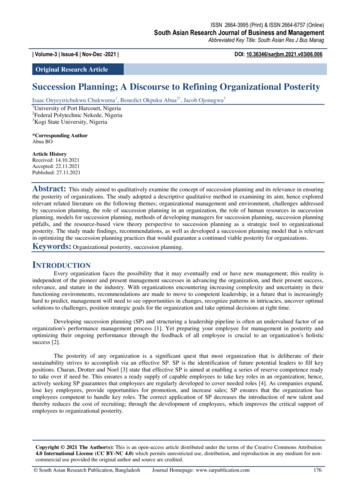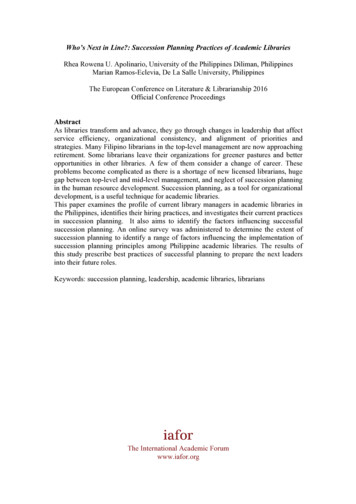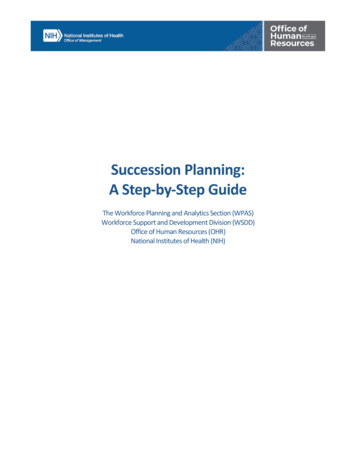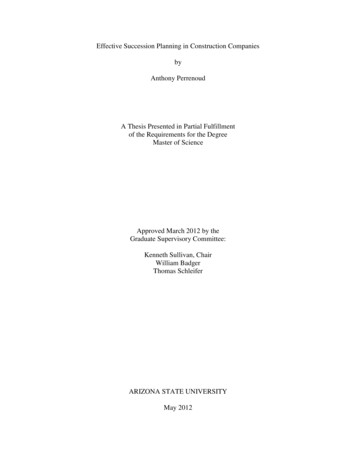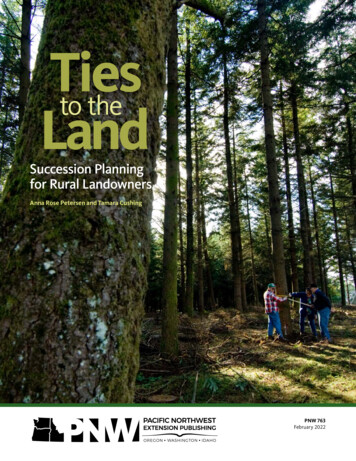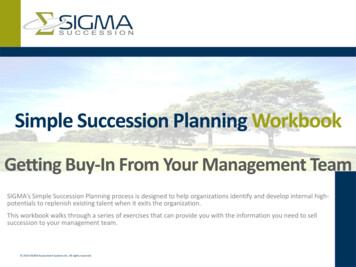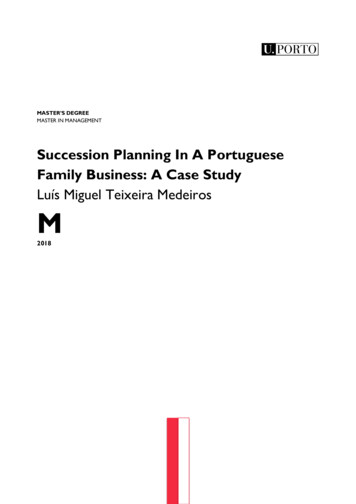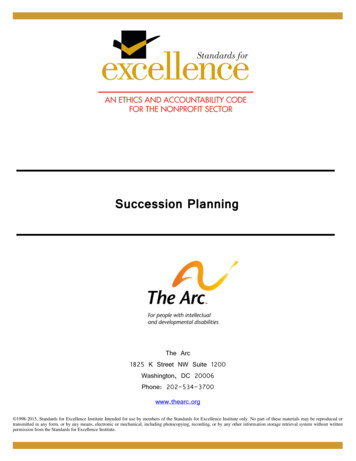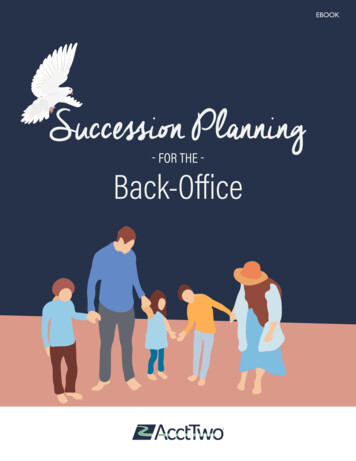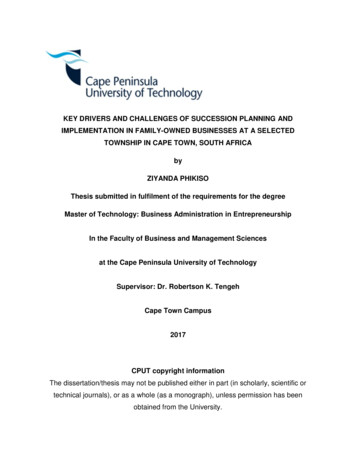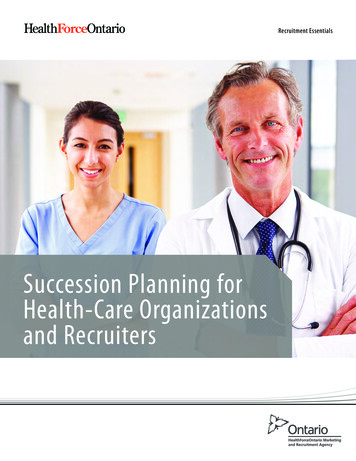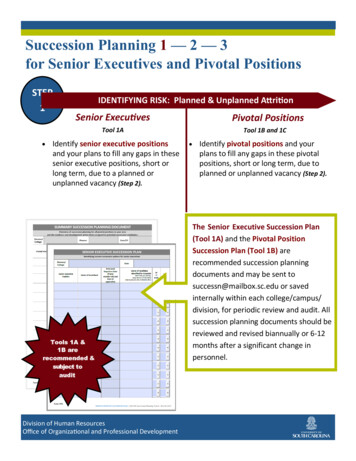
Transcription
Succession Planning 1 — 2 — 3for Senior Executives and Pivotal PositionsSTEP1IDENTIFYING RISK: Planned & Unplanned AttritionPivotal PositionsSenior ExecutivesTool 1B and 1CTool 1A Identify senior executive positionsand your plans to fill any gaps in thesesenior executive positions, short orlong term, due to a planned orunplanned vacancy (Step 2).Tools 1A &1B arerecommended &subject toauditDivision of Human ResourcesOffice of Organizational and Professional Development Identify pivotal positions and yourplans to fill any gaps in these pivotalpositions, short or long term, due toplanned or unplanned vacancy (Step 2).The Senior Executive Succession Plan(Tool 1A) and the Pivotal PositionSuccession Plan (Tool 1B) arerecommended succession planningdocuments and may be sent tosuccessn@mailbox.sc.edu or savedinternally within each college/campus/division, for periodic review and audit. Allsuccession planning documents should bereviewed and revised biannually or 6-12months after a significant change inpersonnel.
SENIOR EXECUTIVE SUCCESSION PLANIdentifying current succession options for senior executivesReturn completed form to successn@mailbox.sc.eduDivision/CollegeSenior ExecutivePositionDateName of IncumbentEstimatedDepartureDate (if any)Name(s) ofCandidate(s)Identified for PotentialShort Term (ST) Backup,Long Term (LT) Fill (or both)Internal (Int.) to USC, or External(Ext.)STLTBothInt.Ext.SENIOR EXECUTIVE SUCCESSION PLAN USC-HR Succession Planning Tool 1A Rev 7.2019
Track Major Action Items to Ensure Development of Potential Succession CandidatesAction ItemFor Candidate NameAssigned To Manage(self/other)DeadlineCompletedEvaluate ongoing for changes in time to departure, successor availability and development schedule and organizationalneeds that may affect succession planning.SENIOR EXECUTIVE SUCCESSION PLAN USC-HR Succession Planning Tool 1A Rev 7.2019
PIVOTAL POSITION SUCCESSION PLANIdentifying current succession options for all pivotal positionsReturn completed form to successn@mailbox.sc.eduDivision/CollegePivotal PositionPlannerName of IncumbentEstimatedDeparture Date(if any)DateName(s) ofCandidate(s)Identified for PotentialShort Term (ST) Backup,Long Term (LT) Fill (or both)Internal (Int.) to USC, or External(Ext.)STLTBothInt.Ext.PIVOTAL POSITION SUCCESSION PLAN USC-HR Succession Planning Tool 1B Rev 7.2019
Track Major Action Items to Ensure Development of Potential Succession CandidatesAction ItemFor Candidate NameAssigned To Manage(self/other)DeadlineCompletedEvaluate ongoing for changes in time to departure, successor availability and development schedule and organizationalneeds that may affect succession planning.PIVOTAL POSITION SUCCESSION PLAN USC-HR Succession Planning Tool 1B Rev 7.2019
Pivotal Roles AssessmentTool 1CEmployee Name:Department:Date:Position Title:Division:Manager:Please indicate the extent to whichyou agree with the followingstatements.1. This role is essential toorganizational success forreaching goals and producingresults.2. This role directly impacts theorganization’s criticalrelationships.3. The loss of a person in this rolepresents significant risk to theorganization.4. It would be difficult to delegatethe duties assigned to this role.5. The skills & competenciesrequired to perform thisposition are highly sought afterin the labor market.6. There is no internal pool forthis position of qualifiedcandidates who could step if itbecomes vacant.7. This position tends to have ahigh turnover rate.8. This position would be difficultto fill because it requires highlyspecialized expertise.9. It would take a long time for anew hire to become fullyfunctional in this position.10. This position leverages longterm partner relationships.Total:Strongly Disagree:Disagree:Disagree Somewhat:Agree Somewhat:Agree:Strongly Agree:HIGHLOW012345VitalMandatory SuccessionPlanSignificantSuccession PlanStronglyRecommendedFundamentalGeneral successionplans as neededNo urgent need forsuccession plan41-5021-4011-200-10A Critical Role significantly impacts the overall essential needsof the organization.A Critical Role may include hierarchical level, specializedknowledge, skills and abilities, external relationships,strategic change initiatives and leadership roles.Source: University of VirginiaManager Comments:PIVOTAL ROLES ASSESSMENT USC-HR Succession Planning Tool 1C Rev 6.2019
Succession Planning 1 — 2 — 3for Senior Executives and Pivotal PositionsSTEP2IDENTIFYING POTENTIAL CANDIDATESShort Term Tool 2Long Term Tool 2Back Up / Interim Identify who has been trained toperform their duties and most criticaltasks in the short term. Can bemultiple people. Identify who could be trained. (Step 3)Potential Replacement Identify who has been developed to fillthis role: duties, relationships,expectations, exposure, etc.? Can bemultiple people.Identify who could be recruited anddeveloped. (Step 3)The Vacancy of Pivotal Position Planfacilitates assessment of risk, anddevelopmentofmitigationstrategies, for key positions.Best practice for discussions andreflection around key positions,organizational structure and thereadiness of potential replacements.Refer to policy HR 2.00 for postretirement employment options.Building our talent pool: over 1,800 LEADgraduates and over 200 graduates in ourleadership development programs — ThePipeline for Academy Leaders (PAL) and theEmerging Leader Program (ELP)Division of Human ResourcesOffice of Organizational and Professional Development
VACANCY OF PIVOTAL POSITION PLANUse this form to facilitate assessment of risk, and development of mitigation strategies, for key positions.Division/PlannerCollegePART 1 – Identify Pivotal Positions and Time to DeparturePivotal Position TitleREFLECTName of IncumbentToday’s DateSpecialized knowledge, skills and abilities (KSA):How will vacancy affect the area in terms of operations and leadership (critical functions, relationships, futuretrends, opportunities, challenges, vision and goals)?Anticipated date or timeframe ofdeparture: (consider retirementeligibility, desire for transfer, etc.)and note reason: Within the year 2-3 years 3-5 years 5-10 yearsDate of departure, if knownHow long will it take to recruit for or replace this position?How long will it take a qualified replacement to become fully functional?How much critical institutional knowledge becomes unavailable with this departure? Does a procedure oroperational guide exist or need developing for this position? If so, please note your plan to accomplish.Does this position need to be refilled/replaced as it currently exists or does this impending departure present anopportunity to restructure the position (PD), department or division to better meet the long-term vision andstrategic goals for this area and the university? Please consider future operations and leadership needs.PART 2 – Identify Potential SuccessionCandidatesUtilize: Tools 3A and 3BBrainstorm individuals, internally and externally, who may have the potential, below or on Tool 5:Use the following succession planning tools to assess the readiness of your selected individuals. To avoid bias,work with members of your management team whenever possible to complete your assessments.1.) Leadership Performance and Potential Assessment: Answer “yes” or “no” to questions and “score” yourindividual employees in the areas of Leadership Performance and Leadership Potential. (Tool 3A)2.) 9 Box-Model: After scoring each individual, plot your results on the 9-Box Model for a bigger picture view ofthe readiness of each person. Review the traits to ensure you have accurately positioned each individual.Note what you, or their manager, should provide each individual to prepare them for a future role. (Tool 3B)Employees identified as candidates for THIS VACANCY move to Part 3.REFLECTReflect on career planning conversations with your staff and other potential candidates across the organization.VACANCY OF PIVOTAL POSITION PLAN USC-HR Succession Planning Tool 2 Rev 2.2018
PART 3 – Designate Trained Back-ups andTop Assessed Succession CandidatesUse the referenced tools, and the table below, to record the individuals selected as candidates for succession:Short-Term Backup –Internal Candidate: Consider who could provide immediate, short-term backup for aposition vacated unexpectedly. If there is not one single individual, consider how you could divide the dutiestemporarily. Do not limit yourself to those individuals in your immediate area. Consider others across theorganization in a role with similar skills and duties.Long-Term Fill - Internal Candidate: Consider high potential employees who are now, or may develop intostrong candidates who could compete for the position through the search and selection process. Consider thosewho have demonstrated an interest in promotion, not fully challenged in their current position, and/or areserving in functions that are becoming obsolete or less critical to operations. Look across the organization.Long-Term Fill - External Candidate: Consider a candidate, external to the organization, who has specializedskills or knowledge not found within the organization nor easily developed internally.NameShort-Term (ST) BackupLong Term (LT) Fill or Both;Internal (Int.) orExternal (Ext.) CandidateIf the individual is not currentlyprepared, briefly note additionalknowledge, skills and abilities(KSA) needed.Capture details on IDP in Part 4.Date ofAnticipatedReadiness ST LT Int. Ext. ST LT Int. Ext. ST LT Int. Ext. ST LT Int. Ext. ST LT Int. Ext.Part 4 – Create IndividualDevelopment Plans (IDP)Utilize: Tool 4REFLECTIf the current manager(s) of the designated candidates are not in a position to develop and provide ongoingsupport for these individuals in the necessary operational competencies and leadership behaviors outlined in theirdevelopment plan - consider moving them under a different, proven leader or identify a mentor from elsewhere inthe organization.Capture development goals in their Individual Development Plan (IDP). Individual Development Plans (IDPs) aretools used to help employees develop their skills by setting goals and then organizing those goals into a cohesiveplan with defined timeframes and expected results. Succession Planners, succession candidates and managerswill work together to tailor the IDP to ensure it meets the needs of the individual and the organization. Thereare four steps to developing an IDP:1.) Analyze Development Needs2.) Set Goals3.) Identify Activities, Training and Experiences 4.) Define Success Criteria and Time LinesNote: It is important to monitor and evaluate IDP results. IDPs evolve as individuals evolve (or not, due to theunexpected, lack of support, opportunities, etc.). Employees, who are not on track with their developmentgoals, will need to be re-evaluated. You may need to accelerate the development of other identified potentialsuccession candidates to fill the gap.Part 5 Evaluate1.) Pivotal Position: has anything changed in their departure date?PREPARE2.) Candidate: is their development on track; are they still employed and engaged; arethey still interested in this role or a different role/career; motivations aligned?TargetEvaluation Date3.) Organization: has anything changed in the organization that could necessitate achange in this plan (direction of organization, vision, goals, talent pool)?Develop plans to onboard the final, selected candidate; initiate strategic salary discussions with HR Class & Comp.VACANCY OF PIVOTAL POSITION PLAN USC-HR Succession Planning Tool 2 Rev 2.2018
Succession Planning 1 — 2 — 3for Senior Executives and Pivotal PositionsSTEP3ASSESSING & DEVELOPING POTENTIAL CANDIDATESIdentify & Assess9-Box Assessment9-Box ModelPotential Talent Pool WorksheetDevelopIndividual Development Plan (IDP)Cross Training and KnowledgeManagement WorksheetThe Office of Organizational andProfessionalDevelopmentisavailable to assist you withdeveloping your succession plans.They have provided multiple tools tosparkimpartialdiscussions,reflection and thoughtful assessmentduring this process. In addition,roadmaps to cross train and developyour potential candidates.Please contact Nathan Strong (73508) or Kim Pruitt (7-3529) to setschedule an appointment.Ongoing career development conversations,planning and exposure are critical to thedevelopment of our existing and future highpotential successors.Division of Human ResourcesOffice of Organizational and Professional DevelopmentRev. 06/2019
PERFORMANCE-POTENTIAL ASSESSMENTWorksheet for populating the Performance and Potential 9-Box Grid: Each succession planner should answer the following questions prior to placing individualson the 9-Box to ensure consistency and remove any bias in assessing your employees’ performance and potential.Employee Name:College/Division & Position:0-3 Low 4-7 Medium 8-10 High 2.3.4.5.6.7.8.Does the employee demonstrate leadership ability—by showinginitiative and vision, delivering on promised results, communicatingeffectively, and taking appropriate risks?Does the employee display an ability to interact comfortably with peopleat a higher level or in different areas?Does the employee demonstrate comfort with a broader organizationperspective than his or her job currently requires?9.Does the employee demonstrate flexibility and motivation to move intoa job that might have different requirements than any they have heldpreviously?10. Does the employee welcome opportunities for learning anddevelopment?To evaluate this employee’s potential, calculate the number of checked boxesin each column (Hi 2 pts., Med 1 pt., Low 0 pt.), check the score box belowand find the corresponding box on Tool 3B (9-Box) and record name. TOTALS0-6 Low 7-13 Medium Low-0Respectfully challenges the status quo, displaying creativity,innovation and progressive thinking; is open, and easily adapts to,new processes, perspectives and changes in business processesand practices, even when generated by others3. Is effective in resolving interpersonal conflict; displays an abilityto stay focused on the situation and negotiate effective solutions.4. Displays excellent verbal and written communication skills bydelivering clear, concise and convincing messages5. High standard of personal conduct: honest, trustworthy,accountable for their actions/responsibilities, and delivers ontheir promises6. Builds strong, positive relationships that create success forthemselves and those around them; effective at mobilizingresources to respond to problems and opportunities as they arise7. Has a positive attitude, is inspiring and inclusive; collaborates andcommunicates respectfully and exemplifies a selfless, teamapproach in accomplishing our mission8. Thinks strategically-understands and pursues opportunities thatfit with broader strategy; applies good judgment in problemanalysis and critical thinking9. Eager to learn and grow, actively seeks personal developmentopportunities and excels at rapidly developing new skillsnecessary to successful job performance10. Actively solicits feedback, responds openly withoutdefensiveness, and learns from feedback and alters behaviorTo evaluate this employee’s performance, calculate the number of“yes” responses (yes 1 pt.), check the score box below and findcorresponding box on Tool 3B (9-Box) and record name.TOTALSCould the employee perform at a higher level, in a different position ortake on increased responsibilities within the next year (consider theperson’s ability only, not whether there is a position available to supportthis growth)?Could the employee perform at a higher level, in a different position, ortake on increased responsibilities within the next three years (considerthe person’s ability only, not whether there is a position available tosupport this growth)?Can you envision this employee performing two levels above his or hercurrent position in the next five to six years?Is the organization likely to value growth of the skills and competenciesof this employee over the next several years?Could the employee learn the additional skills and competencies he orshe needs to be able to perform at a higher or different level?Med-12. 1.Hi-2Is self-motivated and results-focused with a solid history of highjob performance and goal achievementDefining Leadership PotentialNo1.YesDefining Leadership Performance 14-20 High 9 BOX ASSESSMENT USC-HR Succession Planning Tool 3A Rev 2.2018
High/Outstanding (8-10)Exceeds ExpectationsMedium/Good (4-7)Meets ExpectationsLow (0-3)Needs ImprovementLeadership Performance - e:Solid Performer, Trusted, High ProfessionalStrong Performer, Current StarFuture Leader, Star Performer - ReadyQuestionable Performer, Effective, GrindersSolid Performer, Key Player, Core EmployeeStrong Performer, Emerging LeaderUnder/Low Performer, Icebergs, Talent RiskQuestionable Performer, InconsistentSolid Performer, Enigmas, Rough DiamondsHigh Performance/Low PotentialModerate Performance/Low PotentialLow Performance/Low PotentialLow (0-15)LimitedHigh Performance/Moderate PotentialHigh Performance/ High PotentialModerate Performance/Moderate PotentialLow Performance/Moderate PotentialMedium/Moderate(15-22)GrowthModerate Performance/High PotentialLow Performance/High PotentialLeadership Potential - AspirationHigh (23-30)Mastery9-BOX MODEL USC-HR Succession Planning Tool 3B Rev. 2.2018
High/Outstanding (8-10)Exceeds ExpectationsMedium/Good (4-7)Meets ExpectationsLow (0-3)Needs ImprovementLeadership Performance - Ability9-ModelKeySolid Performer, Trusted, High ProfessionalStrong Performer, Current StarFuture Leader, Star Performer - ReadyQuestionable Performer, Effective, GrindersSolid Performer, Key Player, Core EmployeeStrong Performer, Emerging LeaderUnder/Low Performer, Icebergs, Talent RiskQuestionable Performer, InconsistentSolid Performer, Enigmas, Rough DiamondsHigh Performance/Low PotentialTraits: accomplishes all important work; seen as atechnical leader, a subject matter expert (SME) and aresource for others; has reached their potential; good fit intheir role;Goal(s): retention, capture/document their knowledge;use as a lead or trainer for othersProvide: recognition, continue developing them in theirareaModerate Performance/Low PotentialTraits: accomplishes most important things; is not viewedas a leader in their area; proficient in their current roleGoal(s): help employee be successful in their current role;coach to improve their performance; may be a candidatefor a lateral moveProvide: training and development; coaching; recognizetheir improvement effortsLow Performance/Low PotentialTraits: not accomplishing most important things; notmeeting the standards of their current role; not capable ofmaking higher contributionsGoal(s): help them be successful in their role or movethem to a more appropriate position (laterally or demotion)or consider an exit planProvide: diagnose causes (bad hire, lack of information,competencies & skills) and provide: coaching, feedback,performance plan or exitLow (0-15)LimitedHigh Performance/Moderate PotentialTraits: accomplishes all important work; acts as a leaderand role model; may exhibit capability and competenciesbeyond current role; leadership development stillnecessary in some areas; tactical focusGoal(s): engage and develop for next level upProvide: a career progression conversation andopportunities for them to display leadership in theircurrent role: job enlargement, special project, lead ateam; may need lateral transfer if existing managerunable to provide leadership development andopportunitiesModerate Performance/Moderate PotentialTraits: accomplishes most important things; displayssome executive competencies, leadership and ability asa role modelGoal(s): retain in current role and continue developmentfor future potential; may be considered for jobenlargementProvide: more time and developmentLow Performance/Moderate PotentialTraits: not accomplishing most important things; capableof making higher contributionsGoal(s): determine what is lacking for success in currentrole and focus on improving performance, likely to haverange to move up one level/challenge.Provide: Provide coaching, training and developmentand frequent and specific feedback; recognize effortsMedium/Moderate (15-22)GrowthLeadership Potential - AspirationHigh Performance/ High PotentialTraits: accomplishes all important work; exhibitscapability and competencies beyond current role; excelsat relationship building and has wide spread influencebeyond current roleGoal(s): retention, prepare and utilize for successionProvide: a career progression conversation; acceleratedleadership development to include stretch assignments;recognize and reward their effortsModerate Performance/High PotentialTraits: accomplishes most important things;acknowledged as a leader and role model displayingexecutive competencies; displays capability one levelabove current role; strategic focusGoal(s): prepare and develop for promotionProvide: coaching and feedback to improveperformance; identify career goals and support with adevelopment plan and opportunities to learn and grow(team, project)Low Performance/High PotentialTraits: not accomplishing most important things;displays executive competencies and acknowledged as ateam player and role modelGoal: determine and address the root cause(s) of theirperformance problems to maximize their potential; worthyof developmentProvide: diagnostic conversation to identify anyfrustrations and necessary interventions: job fit, managerfit, career aspirations; develop in needed areasHigh (23-30)Mastery9-BOX MODEL USC-HR Succession Planning Tool 3B Rev. 2.2018
Reset FormIndividual Development Plan (IDP)Employee Name:CRITICALBEHAVIORS/GOALSWhat do I want? What do Ineed to learn? Whatspecific behaviors do I needto model or exhibit in thiscompetency or skill?Goal 1 (long-term):Goal 2:Goal 3:Goal 4:Period From:CONTRIBUTION TOORGANIZATIONHow does this help thecollege or departmentmeet its needs?DEVELOPMENTALACTIVITIES/ACTION STEPS(assignments, coaching,formal training)What steps will I take toachieve this? Remember touse SMART goals.MANAGER’S ROLE(or involvement ofothers, if applicable)What resources orsupport will I need?Potential costsinvolved?MEASURESWhat will my successcriteria be?TARGET DATES/MILESTONESWhat is my targetcompletion date?To:RESULTS(manager and/oremployee comments)How have I succeeded inadapting my behavior orlearning new skills?
SupplementalWorksheets &Sample Forms
POTENTIAL TALENT POOL WORKSHEETREFLECT: Does this worksheet reflect a robust and diverse talent pool? Have you considered other talent resource needs (or excess) across theuniversity to address succession-planning university-wide and engage and retain our top talent?POSITION/TITLECURRENTLYHELD BY:CANDIDATESMOST READYTODAY:NEAR TERMCANDIDATES(Potential in1-3 years)FUTURECANDIDATES(Potential in5 Years)POTENTIAL TALENT POOL WORKSHEET USC-HR Succession Planning Tool 5 Rev. 2.2018
Knowledge Management and Transfer (Cross-Training) – WorksheetFor tasks and activities (not entire roles) that need to be captured and cross-trained for continuity of operations.CriticalTo1.) Capturing knowledge that otherwise would exit with the employee and missing, could impede business operations2.) Continuity of business operations during expected/unexpected absences and vacancies: FMLA, Succession, Turnover, Promotion, etc.3.) Onboarding and training new hires more efficiently and effectively through documented onComplete this worksheet with the employee to rank activities in order of importance and designate people for cross training. What core activities do you do at work? Each process name should have a verb (action word). Each process should relate to only one delegable job role.o Examples: conduct performance reviews, conduct interviews, perform monthly reports, reconcile weekly finance statements, schedule all classschedules, reserve all rooms, facilitate a conference, enter all payments, etc. Rank each activity in order of critical business operation importance and supply the amount of time you spend on this task each week.RankRank and Note Each Core Work ActivityDivision or College1Core Work ActivityEst. HoursSpentWeeklyonActivityPrimaryBackup 1Name &DeadlineBackup 2Name &DeadlineAssignedTrainerProcessDocumented(Y/N) &DeadlineAssignedtoDocument2345678910KNOWLEDGE MANAGEMENT AND TRANSFER (CROSS-TRAIN) WORKSHEET USC-HR Succession Planning Tool 6 Rev 2.2018
Core Work Activity / Business Process - Documentation GuidelinesPurpose: When designating an activity as a critical business operation process and assigning it for cross training, create a business process document todefine/outline all aspects of this activity for successful training and to capture as part of your knowledge management strategy. Below is just a sample of thethings necessary to document a process for effective sharing of activity knowledge.Activity/BusinessProcessPurpose of the Activity and the Scope of work.What is the intention/objective of the process (why do it?) and when and where does it apply?RolesRoles of all involved in process and their functions to ensure role clarityContactsExternal contact information – special phone numbers, email addresses for the customer/client/end-user. (ex. special 800# or ext.?)Internal contact information - for those involved in the process.Definitions & AcronymsConsistent operational definitions; acronyms should be defined to ensure proper interpretation Process FlowTools Standards & Guidelines (any standards, policies, rules governing this process)Process (show a flowchart where necessary)Procedures (step 1, step 2, step 3) Consider that many people who perform the same activity, may go about it a different way.Agree on a common process for training, assisting others and reduction of errors. Entry Criteria: what is required before this process can begin - time, an event, receipt, etc. Input Actions: by owner and all involved parties that have a role in this process Output: What deliverables or other output are required of this process and how should they be formatted/delivered? Metrics: Where are measurements captured or automatically entered? Exit Criteria: What is the condition required before the process is declared complete - filed, saved, sent to someoneelse, etc.?Templates (any standardized templates, forms, web links, etc. that will need to be shared to perform this process)Checklists (any checklists that will need to be shared to perform this process)Training (any specialized training, skills or certifications necessary to perform this process)Equipment/Software necessary to those performing this activity/processApprovals/VerificationsWho needs to review, approve or verify this data to consider it completed? Is there a checklist to fill out or an approval form? Is thisprocess monitored or audited, and filed a certain way or sent to others?DeadlinesWhat is the start to finish timeframe of this process? It is due daily, weekly, monthly or annually?KNOWLEDGE MANAGEMENT AND TRANSFER (CROSS-TRAIN) WORKSHEET USC-HR Succession Planning Tool 6 Rev 2.2018
PIVOTAL POSITION SUCCESSION PLANIdentifying current succession options for all pivotal positionsReturn completed form to successn@mailbox.sc.eduDivision/CollegePivotal PositionPlannerName of IncumbentEstimatedDeparture Date(if any)DateName(s) ofCandidate(s)Identified for PotentialShort Term (ST) Backup,Long Term (LT) Fill (or both)Internal (Int.) to USC, or External(Ext.)STLTBothInt.Ext.Director of StudentsSally Jones6/30/18Jim MaySTInt.Director of StudentsSally Jones6/30/18Sammie NorthSTInt.Director of StudentsSally Jones6/30/18Maggie SmithLTInt.Director of HRTim West12/31/17Cleo CapableLTInt.Director of HRTim West12/31/17Betty FocusLTInt.Director of HRTim West12/31/17James AbleLTInt.Director of FinanceBarbara Case4/27/18Bill SugarSTExt.Director of FinanceBarbara Case4/27/18Maggie TrainorSTInt.Director of HousingJerry Lexar12/31/17Kelly BakerSTDirector of HousingJerry Lexar12/31/17Larry JamesSTDirector of HousingJerry Lexar12/31/17Rachel MooreSTInt.PIVOTAL POSITION SUCCESSION PLAN USC-HR Succession Planning Tool 1B Rev 2.2018
Track Major Action Items to Ensure Development of Potential Succession CandidatesAction ItemFor Candidate NameAssigned To Manage(self/other)Include Betty at all leadership meetingsand ask her to present and represent thegroup for her areaInclude Betty in higher-level decisionmaking opportunities. Ask for hersuggestions.Cleo should meet with 3 key institutionalpartners in finance, provost and HR tolearn more about our processesCleo should work on her skills in the areasof reporting and analysisJames should complete LEAD trainingBetty FocusAVP of HRBetty FocusAVP of HRCleo CapableCleoCleo CapableCleoJames AbleJamesJames to become a lead in his area with 1full time employee and 2 student workersInvolve James in problem solving; ask forhis opinion, coachJames AbleDirector of HRJames AbleDirector of 2018Evaluate ongoing for changes in time to departure, successor availability and development schedule and organizationalneeds that may affect succession planning.PIVOTAL POSITION SUCCESSION PLAN USC-HR Succession Planning Tool 1B Rev 2.2018
VACANCY OF PIVOTAL POSITION PLANPART 1 – Identify Pivotal Positions and Time to DepartureUse this form to facilitate assessment of risk, and development of mitigation strategies, for key positions.Division/Division of EducationPlanner Frank DustinCollegeREFLECTPivotal Position TitleName of IncumbentToday’s DateDirector of HRTim West5/1/17Specialized knowledge, skills and abilities (KSA):15 years or more experience in strat
plan with defined timeframes and expected results. Succession Planners, succession candidates and managers will work together to tailor the IDP to ensure it meets the needs of the individual and the organization. There are four steps to developing an IDP: 1.) Analyze Development Needs 2.) Set Goals 3.)
